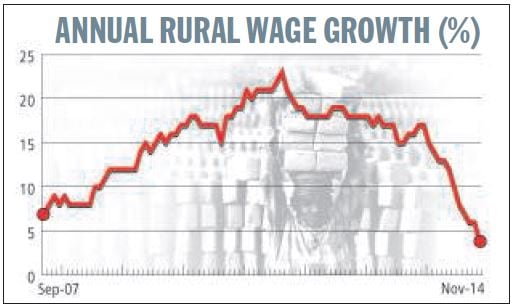Rural wages in India have registered an average annual growth of 3.8 per cent in November, the lowest since July 2005, according to Labour Bureau data.
The 3.8 per cent year-on-year increase is a significant drop relative to the two-digit growth rates prevailing until June, and the peak 20 per cent-plus levels of 2011 (see graph).


“The numbers confirm the findings in our mid-year economic analysis that inflation is coming down sharply and, probably, sustainedly,” the chief economic advisor in the Finance Ministry, Arvind Subramanian, told The Indian Express.
The deceleration in rural wages — the 3.8 per cent nominal growth is lower than the annual consumer price inflation of 4.09 per cent for rural India in November — could further strengthen the case for the Reserve Bank of India (RBI) to initiate policy interest rate cuts sooner than later.
In a speech on ‘Fighting Inflation’ delivered last February, RBI Governor Raghuram Rajan had underlined the role of rural wages as a major determinant in food price increases and boosting inflation expectations in general.
“Nominal rural wages have grown at a sharp pace during the last five years. Econometric tests suggest causality has flowed from wages to prices”, he had said.
The current moderation in rural wage growth, to the extent it is seen to be helping “anchor” inflation expectations, may go some way in influencing the RBI’s monetary policy actions in the coming days.
Story continues below this ad
“It is a positive development no doubt, but the central bank would also take into account other factors while deciding on monetary policy”, said D K Joshi, chief economist at the rating agency Crisil.
Subramanian said that the lower rural wage increases is further proof that “monetary conditions are getting tighter”. If the fall in inflation is happening faster than expected, it means that the RBI’s “real policy rate (repo rate minus inflation) is becoming greater”.
In other words, the case for slashing interest rates has become all the more strong now.
The Labour Bureau data showed the average all-India daily wage rate across 23 agricultural and non-agricultural occupations at Rs 266.26 for November 2014, as against Rs 256.52 for the same month of the previous year. The figures are based on a revised categorisation of occupations with effect from November 2013, and hence comparable.
Pronab Sen, chairman of the National Statistical Commission, attributed the rural wage slowdown, especially over the past 6-7 months, to the reversal of the factors that stoked it in the first place.
Story continues below this ad
Rural wages started going up in 2007, thanks to increased non-farm employment opportunities in a booming economy aided by improved road and telecom connectivity. This was further enabled by MGNREGA and rising crop prices that made it possible for farmers to absorb the wage increases.
All three drivers are showing weakening now. A slowing economy has led to a drying up of job opportunities for rural migrant workers, especially in sectors like construction and manufacturing. The crash in prices of most crops has, likewise, reduced the scope for pass-through of wages by farmers.
And finally, MGNREGA appears to have lost its bite. “We have had a change of government, due to which the emphasis on MGNREGA has been somewhat lost. It has to come back”, Sen said.

 The figures are based on a revised categorisation of occupations with effect from November 2013, and hence comparable.
The figures are based on a revised categorisation of occupations with effect from November 2013, and hence comparable.







